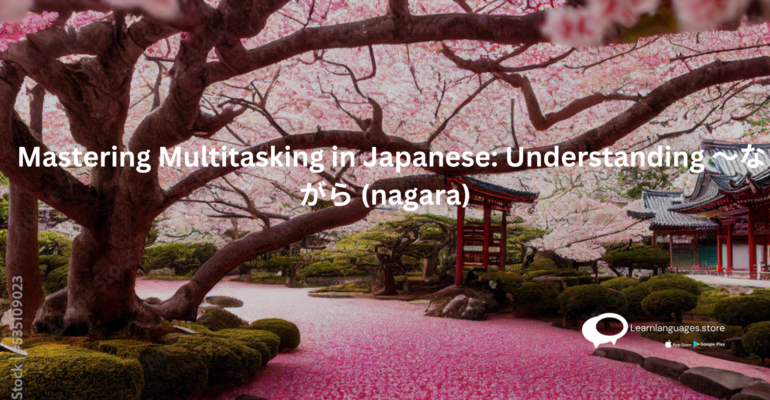Mastering Multitasking in Japanese: Understanding 〜ながら (nagara)
Mastering Multitasking in Japanese: Understanding 〜ながら (nagara)
Estimated reading time: 3 minutes

INTRODUCTION:
Konnichiwa, language lovers! Today, we delve into the fascinating world of Japanese grammar, focusing on the versatile phrase 〜ながら (nagara). This handy expression allows us to describe actions happening simultaneously, perfect for those who love multitasking. Whether you’re walking and talking or eating and studying, 〜ながら (nagara) is your go-to phrase. Let’s explore how to use it with humor and precision!
Understanding 〜ながら (nagara):
In Japanese, 〜ながら (nagara) means “while doing” and is used to describe two actions happening simultaneously. This expression is attached to the verb stem of the first action, followed by the main action in its plain form.
Sentence Structure:
The structure for using 〜ながら (nagara) is as follows:
[Verb stem] + ながら + [Main action in plain form]
Let’s break it down with some fun and humorous examples:
- 歩きながら歌う。 (Aruki nagara utau.) English: “Sing while walking.” Hindi: “चलते हुए गाना।” (Chalte hue gaana.) Pronunciation: “चालते हुए गाना।” Romaji: “Chalte hue gaana.” Imagine a friend singing loudly while walking down the street, causing passersby to give amused looks.
- テレビを見ながら勉強する。 (Terebi o mi nagara benkyou suru.) English: “Study while watching TV.” Hindi: “टीवी देखते हुए पढ़ाई करना।” (TV dekhte hue padhai karna.) Pronunciation: “टीवी देखते हुए पढ़ाई करना।” Romaji: “TV dekhte hue padhai karna.” Picture a student with a textbook in one hand and the TV remote in the other, trying to balance study and entertainment.
- 食べながら話す。 (Tabe nagara hanasu.) English: “Talk while eating.” Hindi: “खाते हुए बात करना।” (Khaate hue baat karna.) Pronunciation: “खाते हुए बात करना।” Romaji: “Khaate hue baat karna.” Visualize a family dinner where everyone is enthusiastically talking with their mouths full, sharing stories and laughter.
Exceptions and Usage:
While 〜ながら (nagara) is straightforward, there are a few nuances to remember:
- Concurrent Actions: The two actions described with 〜ながら (nagara) should be able to happen simultaneously. For example, “運転しながら寝る” (unten shinagara neru) “sleep while driving” is illogical and unsafe!
- Emphasis on Main Action: The main action typically follows 〜ながら (nagara) and holds the primary emphasis of the sentence.
Identifying in a Sentence:
In the sentence “歩きながら歌う” (Aruki nagara utau), “〜ながら (nagara)” is used to indicate that the person is singing and walking simultaneously. This shows the versatility of the phrase in describing concurrent actions.
Conclusion:
Congratulations, dear readers! You’ve now mastered the art of multitasking in Japanese with 〜ながら (nagara). Whether you’re combining study and leisure or simply adding humor to your daily routines, 〜ながら (nagara) enriches your expressions and showcases your multitasking skills.
Arigatou gozaimasu for joining me on this linguistic journey. Until next time, mata ne! 🎌
-
Product on sale
 Japanese N4
Japanese N4₹18,300.00
₹24,300.00 -
Product on sale
 Japanese N5
Japanese N5₹16,300.00
₹18,300.00
Learn Languages Store
Vashi,
Email: services@learnlanguages.store










